I’ve always preferred the lovely botanical name Paeonia.
Zou Chuan An (1941- ). Flowers and Birds. Chinese Gongbi Painting
The contemporary Chinese artist Zou Chuan An (1941- ) paints in a traditional style, using a technique known as gongbi (meticulous). Depicted in this wonderful painting is the common Chinese tree peony, Paeonia suffruiticosa [pay-ON-ee-a su-fru-ti-KO-sa]. Tree peony is a shrub, easily distinguished from its herbaceous perennial cousins, familiar garden varieties of Paeonia lactiflora, by its persistent woody stems. My friend Jane grows both types, and she sent me beautiful photos. I think I’ve correctly identified most of them.
Photos by Jane Bodine
I don’t know how any gardener can resist tree peonies.
Paeonia ostii ‘Phoenix White’ blooming in Jane’s garden: large, perfect snowy petals open to reveal golden stamens clustered around a red center
The common tree peony has been cultivated in China for sixteen centuries and is represented by more than 1000 local varieties. Cultivated Chinese tree peonies have a complicated history, involving multiple Paeonia species, populations and locations. In addition, traits of cultivated tree peonies have diverged from wild Chinese species, particularly in flower size, petal count and color. This makes it difficult for Chinese botanists to sort out the domestication history of the tree peony; DNA profiles may be key.
“Flowers float like silk”
‘Phoenix White’ tree peony opening in the dewy morning after closing over night
Here’s the Cricket Hill Garden catalog description of Paeonia ostii ‘Phoenix White’:
“Flowers float like silk on top of the leaves. This is a cultivated variety of the wild species tree peony Paeonia ostii. It is a very versatile garden plant that is adaptable to harsh growing conditions. Planted in shadier areas it will still grow and flower well. ‘Phoenix White’ has been commercially grown for at least 500 years in central China. The roots of tree peonies are used in traditional Chinese medicine. They possess yin qualities and are used in combination with other herbs to treat a range of maladies, including liver ailments.”
‘Phoenix White’ tree peony in bud and bloom in Jane’s garden
The variety ‘Feng Dan Bai (‘Phoenix White’) originated in Tongling County, Anhui Province, China hundreds of years ago; its mature size is 5 x 4′ at ten years. Single white flowers are very large, about 8 – 9″ across and fragrant.
“I cut a tree peony for my friends Rachel and Owen. It was huge.”
‘Phoenix White’ tree peony bloom going over and folding like a huge snowy handkerchief
a view of Jane’s spring garden with Chinese tree peonies and lilac
Will the real burgundy tree peony, please stand up!
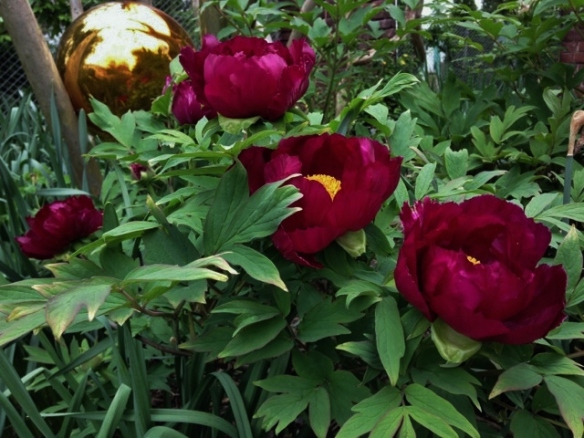 Paeonia suffruiticosa ‘Burgundy Wine’ is the real burgundy tree peony in Jane’s garden
Paeonia suffruiticosa ‘Burgundy Wine’ is the real burgundy tree peony in Jane’s garden
Here’s the Klehm Song Sparrow Nursery Catalog description of Paeonia suffruiticosa ‘Burgundy Wine’:
“A very floriferous plant with good strength and excellent vigor and substance. Deep burgundy wine fully open blossoms show a center of yellow stamens.”
Hardly a poetic description, no, Klehm and Domoto have chosen the perfect name for their wine dark peony, so we need only a brief description of how their aristocratic tree peony grows. Including parentage is a bonus: ‘Burgundy Wine’ is a seedling of Moutan (Paeonia suffruiticosa) raised by Toichi Domoto, the Japanese American nurseryman noted for hybridizing camelias, tree peonies and Japanese maples (Acer palmatum). ‘Burgundy Wine’ (Domoto 1987) was introduced by Roy Klehm of Song Sparrow Nursery in 1995.
superb semi-double flowers of ‘Burgundy Wine’ Chinese tree peony seem to twist as they unfurl fluted petals, gradually revealing a tight cluster of golden-yellow stamens, which echo the golden flowers of Kerria japonica mirrored as a backdrop in Jane’s spring garden.
‘Burgundy Wine’ Chinese tree peony makes a vigorous 3 – 4 x 3′ shrub with handsome, clean, red-tinged foliage, contributing abundant bloom to Jane’s spring border
large, semi-double flowers of ‘Burgundy Wine’ Chinese tree peony hold their distinctive dark red color against handsome deeply cut foliage tinged crimson; then peony petals blue to magenta as they shatter
Paeonia suffruiticosa ‘Burgundy Wine’ Chinese tree peony produces one bud per strong stem and makes an excellent cut flower clothed in deeply cut foliage tinged crimson
Herbaceous Garden Peonies
“The herbaceous peony is the one we are accustomed to see in some not very attractive shades of red or pink in cottage gardens. Do not condemn it on that account.There are many varieties either single or double, ranging from pure white through white-and-yellow, to shell-pink, deep pink and the sunset you find in P. peregrina.
V. Sackville-West. In Your Garden, 4 Sept 1949
Jane called in early June, enthusiastic about her visit to a peony farm out near Longwood in Chester County. She described walking through fields of herbaceous peonies, and the thrill of being surrounded by pastel peony blooms stretching to the horizon, which she likened to an impressionist painting.
“There were acres and acres of nearly 100 varieties of peonies outstretched over rolling hill country amidst wild grasses and in some areas California poppies. It was windy that morning–propelling rivers of motion in the fields.”
a worker gathers fresh-cut peony flowers 1 June 2014
“Imagine the WONDER of coming upon this tucked in the heart of a peony! Exquisite.”
Herbaceous peonies, the garden peonies most of us inherit or choose to plant, are the most long-lived of any perennial garden plants. When I was in horticulture school, I lived on Maplewood Ave. in Germantown, and from my second floor window I could see a lovely wild spring scene in the abandoned back garden of the adjacent house on Schoolhouse Lane: a field of tall grass and dandelions punctuated with big bunches of pink double peonies. When I went back to check a few years later, they were gone, lost under the construction presumably when the building was extended; otherwise, double pink peonies would bloom forever in a field of grass and dandelions.
“To be practical, there is much to recommend the peony. I will make a list of its virtues. It is a very long-lived plant, increasing yearly in vigour if you will only leave it undisturbed. It likes to stay put.”
V. Sackville-West. In Your Garden Again, 22 June 1952
In May Jane’s garden is a profusion of white, pale pink, violet and coral blooms
Jane’s garden blooms in profusion in successive waves as tulips and spring bulbs give way to peonies and iris, and roses and clematis to lilies and daylilies, and summer annuals to fall delights. In May, Paeonia ‘Krinkled White’ dominates the foreground with its large, crisp, creamy petals and golden-yellow stamens, tall bearded Iris ‘Clarence’ in white with violet falls contributes a streak of violet-blue contrast, and ‘Coral ‘n Gold’ single peonies transition to roses behind, where taller Bourbon rose ‘Souvenir de St. Anne’ fills the background, putting on quite a show with a mass of fragrant, semi-double, shell pink, blooms. Finally, Jane’s magnificent cerulean urn draws the eye to the right, and then farther back, we notice a swirl of magenta on a trellis as ascending blooms of Clematis ‘Rouge Cardinal’ open. Beautiful. And so satisfying.
large creamy, single flowers of Paeonia ‘Krinkled White’ interface with fragrant clusters of semi-double Bourbon rose ‘Souvenir de St. Anne’ while a ‘Coral ‘n Gold’ single peony peaks out on the left and Jane’s cerulean urn is visible on the right
Lauded on both sides of the Atlantic and cherished by gardeners since its introduction in 1928, Paeonia ‘Krinkled White’ is a winner by any standard: its single crepe paper like flowers are large and fragrant carried on strong stems, making it an excellent garden and landscape specimen for which it won The American Peony Society Award for Landscape Merit (ALM).
single ‘Krinkled White’ peony and its foregrounded foil: tall bearded Iris ‘Clarence’ flowers of palest bluish-white with dramatic violet-blue falls
Visiting Jane’s garden is always satisfying.
Here is the handiwork of a skilled gardener. The beautiful yet subtle combination of single peonies, semi-double roses, and tall bearded iris is the result of thoughtful planning, artful design and good gardening practice.
Jane loves singles, and so do I.
dazzling single peony ‘Coral ‘n Gold’ resembles a poppy with its vivid cupped reddish-orange petals enhanced by a center of golden stamens.
Imagine a field of ‘Coral ‘n Gold’ poppy-like single peonies.
Claude Monet. Coquelicots (Poppies), 1873
lovely single Paeonia ‘Coral ‘n Gold’
Paeonia ‘Doreen,’ Imperial or Japanese style peony boasts showy fuchsia-pink petals with large glowing stamenoid centers
Paeonia ‘Doreen’ is a classic Japanese style peony, distinguished from single and Anemone type flowers by its central cluster of stamens which have been transformed into slender petals or stamenoids.
Paeonia ‘Do Tell’: “This is one of my favorite shots–such an exquisite peony.”
Jane’s exquisite peony ‘Do Tell’ is also a classic Anemone-type flower, similar to Japanese, but staminoids are even more petal-like petaloids.
Paeonia ‘Bowl of Beauty’ opening in the dewy morning light after closing over night
Paeonia ‘Bowl of Beauty’ with cupped cerise-pink petals and a central mass of narrow, creamy-white petaloids in classic Anemone-form
Peonies are classified by their flower forms: single, semi-double, Japanese or Imperial, Anemone, Double, and Bomb. Any questions, follow the flower forms link or check with the American Peony Society. I’m no peony expert. I hope my discussion of the distinctions and Jane’s beautiful photo illustrations make it clear. I do think it perfect that Jane grows each type of peony flower form. Up next: Bomb.
Paeonia ‘Red Charm’ Bomb type flower
Paeonia ‘Red Charm’ is so double it’s exploding in classic “Bomb” form; it’s like a double flower with many petals, but the stamens are transformed to substantial petals in the center forming a round ball or bomb, sometimes in a contrasting color. The term probably derives from bombe glacée, a spherical ice cream dessert.
Paeonia ‘Red Charm’ in perfect Bomb-form, sets the standard for crimson hybrid peonies
“The secret of growing the herbaceous peonies is to plant them very shallow and give them a deep, rich root-run of manure for their roots to find as they go down in search of nourishment. They will go ahead, and probably outlive the person who planted them, so that his or her grandchild will be picking finer flowers fifty years hence.”
V. Sackville-West. In Your Garden Again, 22 June 1952
Intersectional Peonies: the Itoh Hybrids
Intersectional peonies are hybrids between herbaceous peonies and tree peonies created by Japanese hybridizer Dr.Toichi Itoh in 1948 and are therefore referred to as Itoh hybrids.
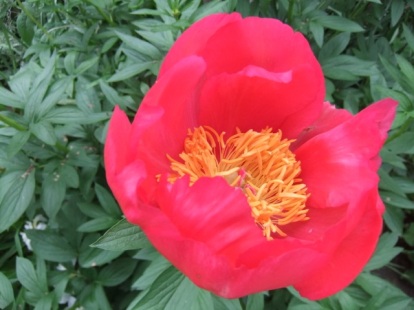 Helen received this beautiful strawberry-red Itoh hybrid peony as a graduation gift in 2002, probably Paeonia x ‘Julia Rose’ blooming in her garden in early June 2014
Helen received this beautiful strawberry-red Itoh hybrid peony as a graduation gift in 2002, probably Paeonia x ‘Julia Rose’ blooming in her garden in early June 2014
Another unnamed peony, I’m not complaining. I’d never heard of intersectional peonies until Jane sent pictures of Helen’s. Fortunately, there are not many on the market; unfortunately, Itoh hybrids change color so much as they open, and some also fade dramatically, like Helen’s. It’s difficult to identify. Let’s face it, if I’ve learned one thing about peonies by writing the text to accompany Jane’s wonderful photos, I’ve learned that peony flowers are nearly impossible to reproduce for id purposes (except ‘Do Tell’), especially tree peonies. I had a devil of a time identifying Jane’s and had given up on the burgundy red when I decided to type in “burgundy” as a descriptor. I got a hit: “Burgundy Wine” appeared on the screen, a Klehm introduction, where Jane purchased all of her peonies over the years, accompanied by terrible pictures, and a perfect description.
My best guess to name Helen’s Itoh hybrid is Paeonia x ‘Julia Rose.’ Here’s the Solaris Farms catalog description:
“Flowers have a cream base color heavily overlaid in bright rose. Colors fade to amber, copper and yellow blends with pink highlights.” Bright rose seems right and fading to pink; photos are the correct colors but seem to show flowers with too many petals for a semi-double peony. Anyway, they look nothing like Jane’s pictures.
Here’s the Peony Farm catalog description:
“Intersectional. ‘Julia Rose’ opens cherry red, fades to apricot-yellow then yellow as the bloom matures. Shows 3 colors at the same time. An attractive mix of variously colored blooms on one plant!” The photos are excellent and do resemble Jane’s, at least the fully open fading bloom. Helen’s Itoh hybrid probably is Paeonia x ‘Julia Rose’
probably Paeonia x ‘Julia Rose’ blooming with Allium christophii in Helen’s garden
probably Paeonia x ‘Julia Rose’ fading to pink in Helen’s garden
“It always seems to me that the herbaceous peony is the very epitome of June. Larger than any rose, it has something of the cabbage rose’s voluminous quality, and when it finally drops from the vase, it sheds its vast petticoats with a bump on the table. . .”
V. Sackville-West. In Your Garden Again, 22 June 1952
“It’s wonderful to catch the moment a peony spills its multitude of petals”
It’s gratifying to know that gardeners across time and place have similar experiences, like Vita Sackville-West and my friend Jane commenting, each in her unique voice, on the moment a peony shatters in the vase. Both are gardeners who love the garden with an intimate knowledge of the whole and of each plant. At sunset when the work of tending her garden is over, she cuts a few carefully chosen bud and blooms, and brings the garden indoors. These, too, she knows intimately even as each stem gradually opens to full-blown and shatters.
See links below for peony sources. Jane orders from Klehm’s Song Sparrow Nursery. When I worked at the Morris Arboretum, we ordered our white peonies and blue iris from Roy Klehm for the border above the rock wall in the rose garden. Like most peony growers, Klehm’s ships in the fall: fresh, bare root plants with 2 -3 eyes. Helen’s friend Kathleen Gagan runs Peony’s Envy nursery and display gardens in Bernardsville, NJ off 287 south of Morristown, the only display gardens in the area so worth taking a ride. Photos on the website are excellent.
Sources for peonies:
Resources
Martha Stewart: visits a fabulous tree peony garden 5/27/14

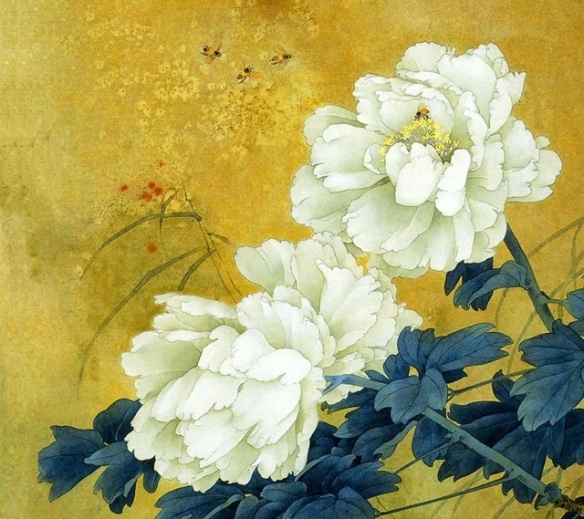
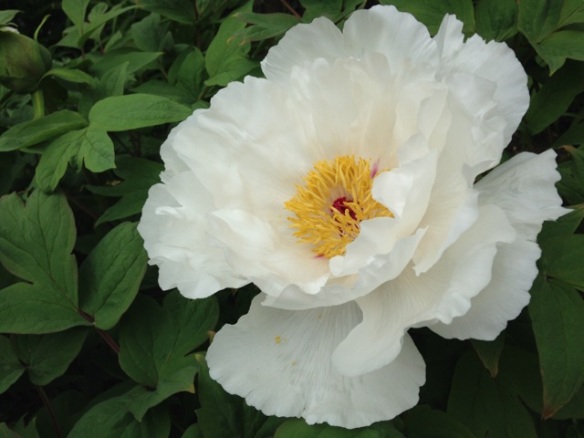
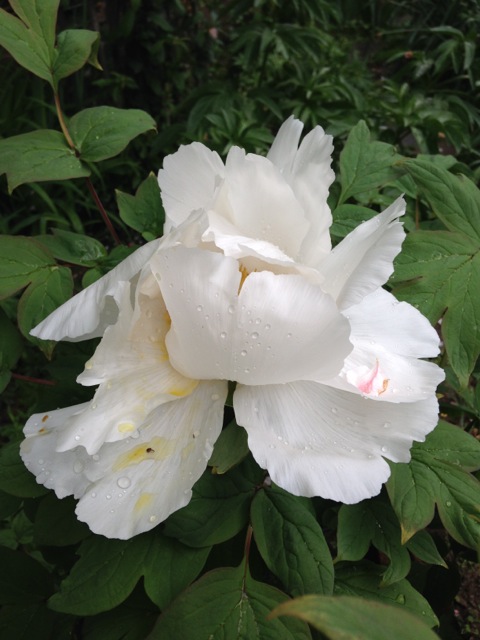
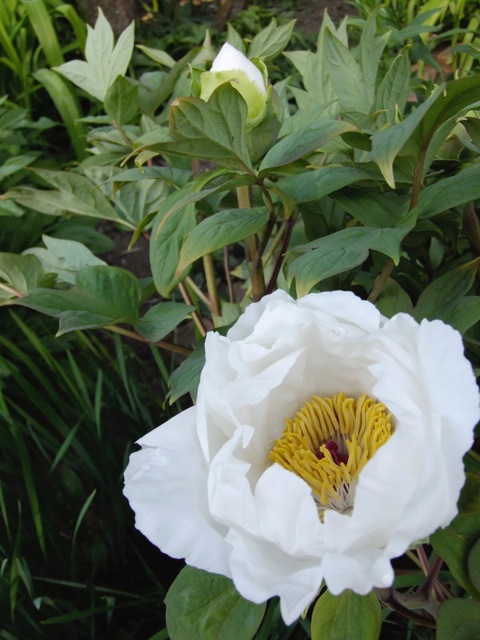
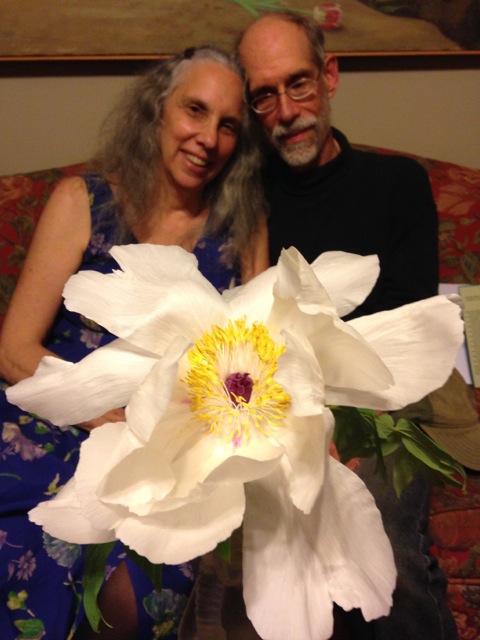

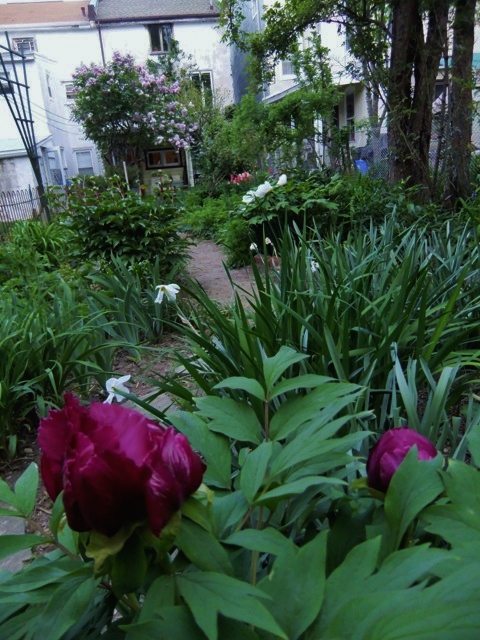
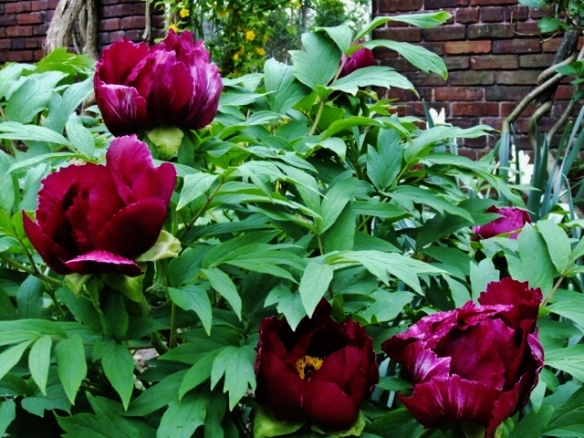
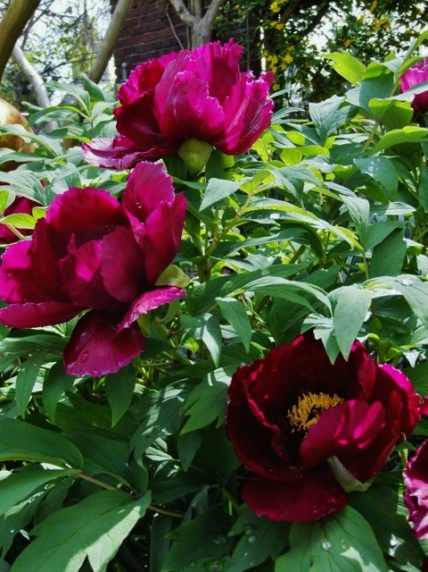
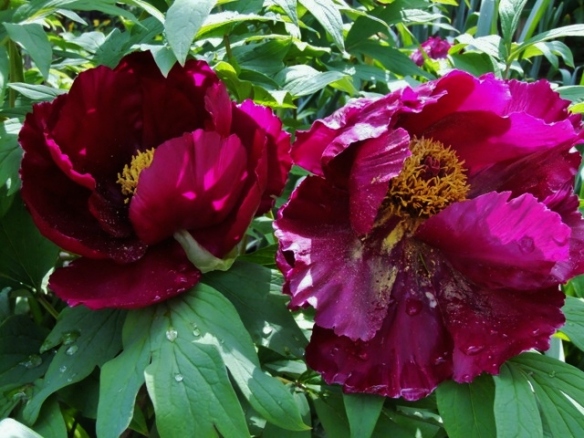
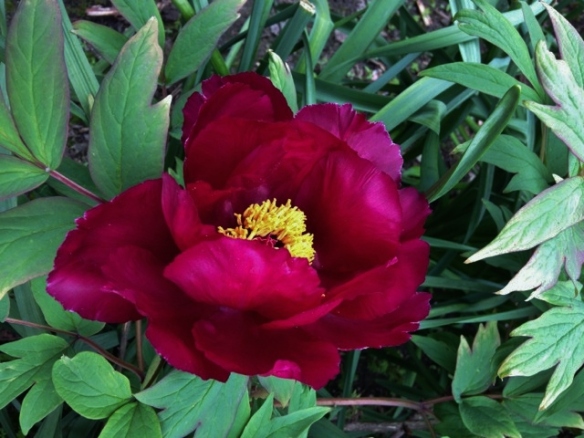
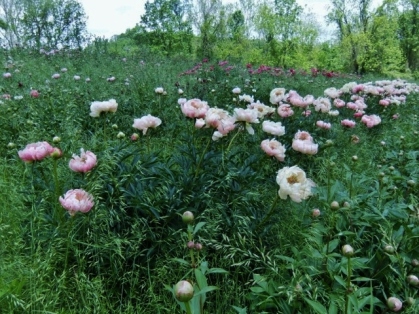

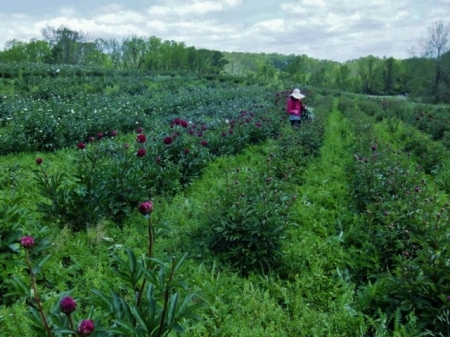
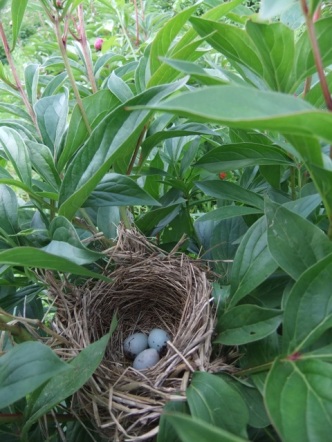

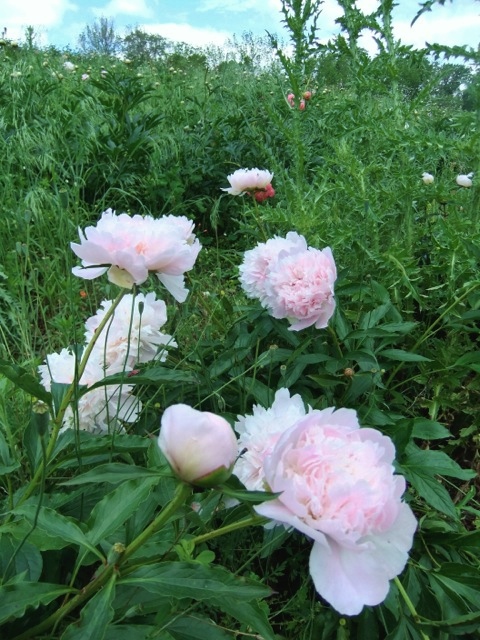
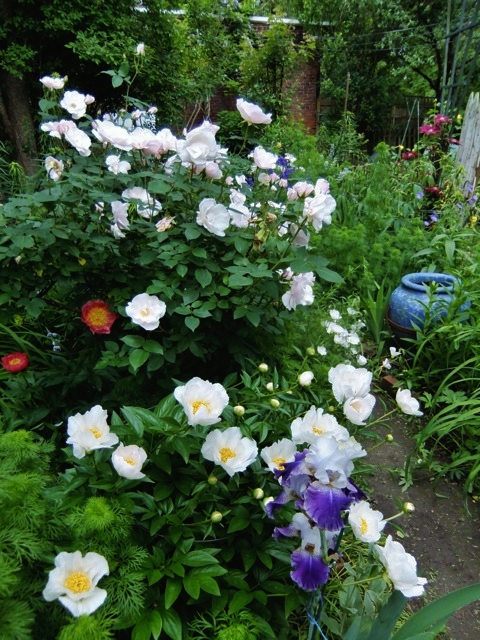
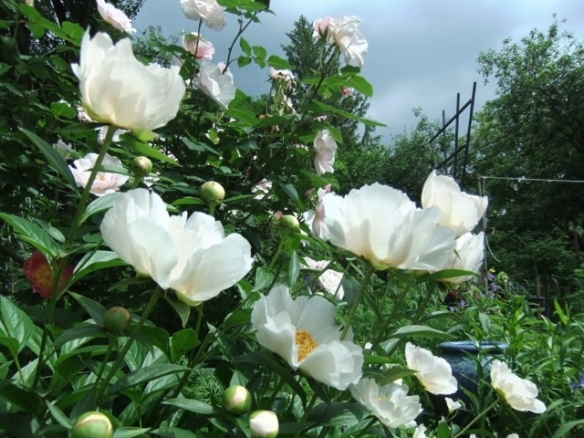
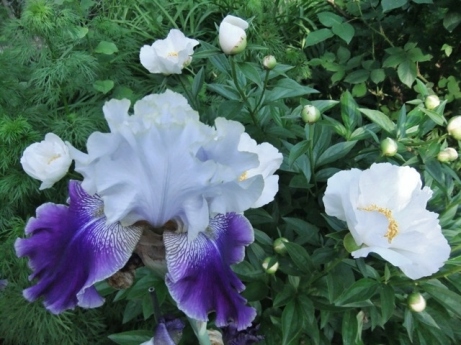
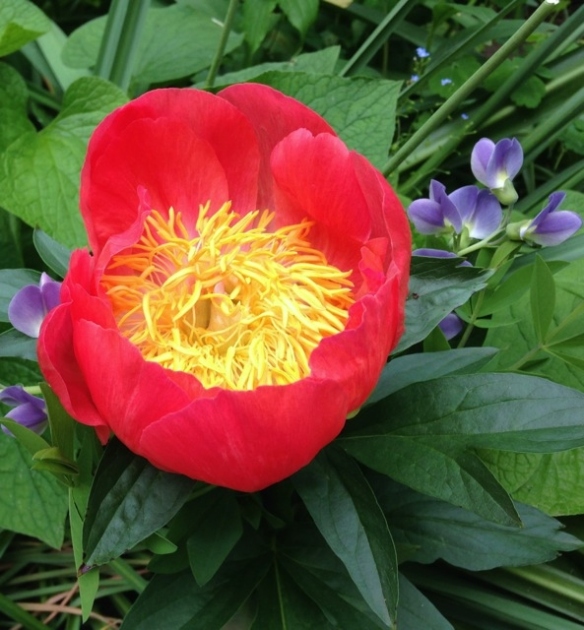

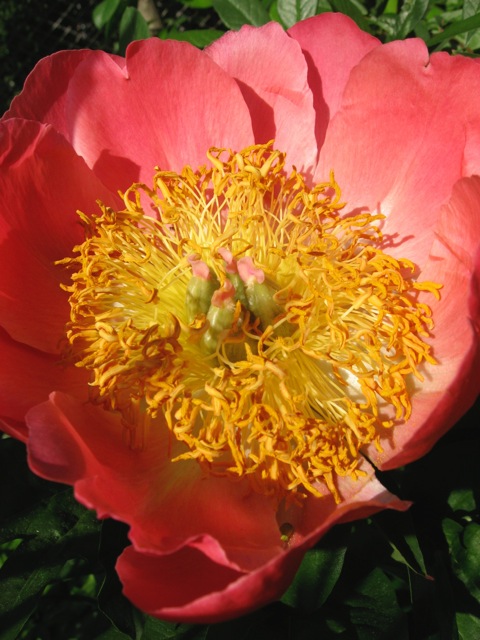
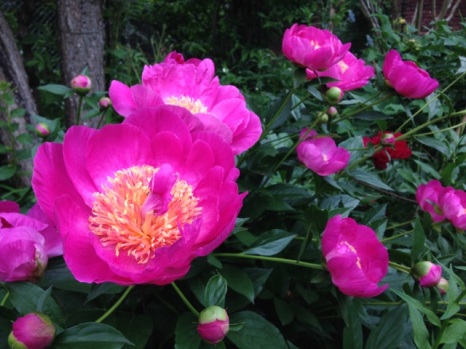
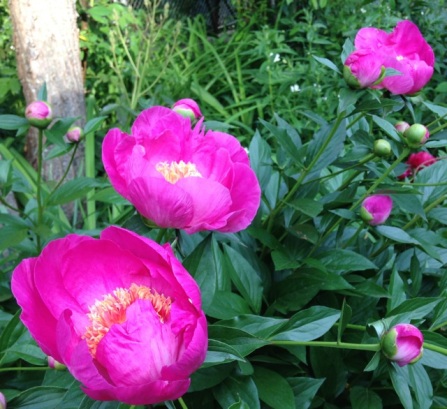
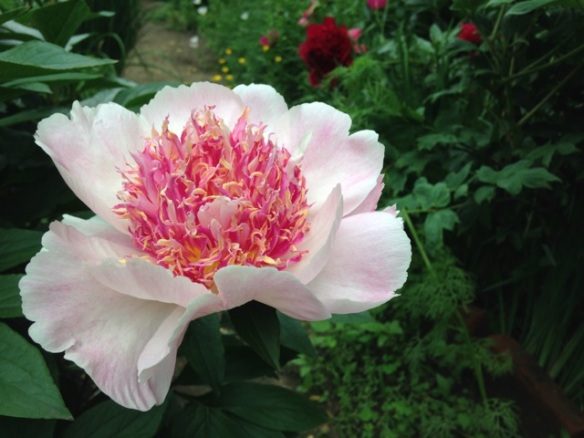
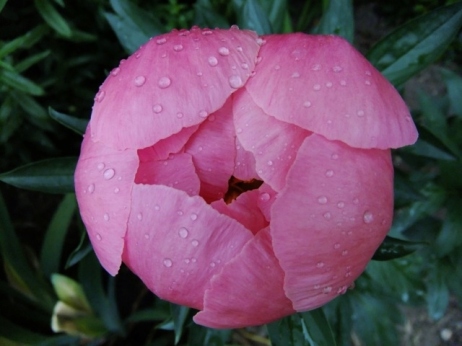
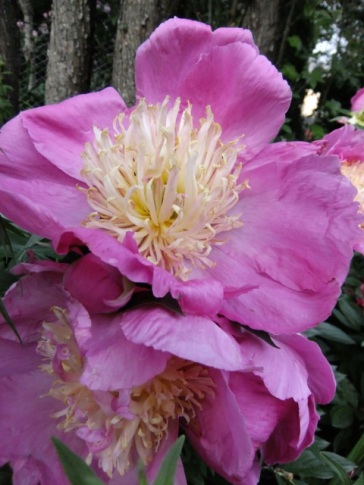
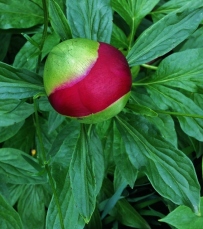

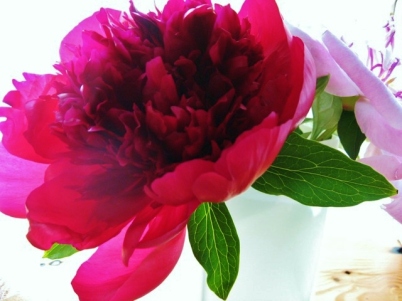
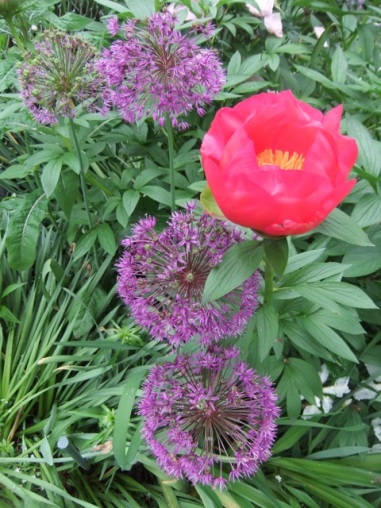
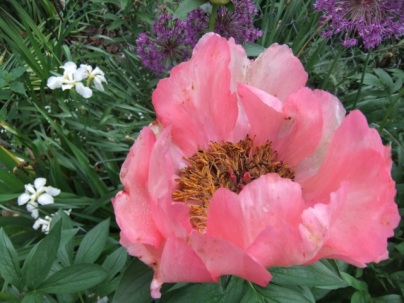

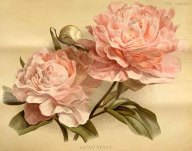
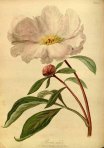
Jude, your peonies are GORGEOUS! Whaat on earth did you feed the mammoth one depicted with your friends??!!
Jan,
These are my friend Jane’s peonies and photos. I know Jane’s garden soil is rich in organic matter because she incorporates compost annually, so no fertilizing is necessary. She also gives plants a good start, planting them in rich organic soil, mulching, and irrigating as needed. You can sink a shovel down to about a foot or so in Jane’s garden with no effort. Her soil is beautiful, so well worked, and tended, the life of the garden. It’s no wonder she gets those huge blooms.
Spectacular. Brava, Jane! I had no clue there were so many varieties. Excellent photos!
Yes. Brava, Jane.
Laura,I love the photograph that Judy took of you in the Amherst cemetery! To take a look at some of the near endless varieties of peonies enter Klehm’s song sparrow catalog 2014,tap peonies and delight -then click on view all peonies. Are there any in your garden?
I am fortunate to have collaborated a bit on this piece with Judy. She persisted in identifying every one. Now that it is complete we see that she has created and woven together such a superb salute to peonies. I have always loved Judy’s over the top enthusiasm. We spoke after the last revision; her enthusiasm was spilling through the phone–one wave after another.
Judy, you are a prize!
Gorgeous and beautiful and amazing. I am paeonia deprived.Thank you Jane for growing them and you for taking the time to tell us about them. “Keep on swimming.” Dory from Finding Nemo. My favorite saying.
Sent from my iPad
>
Hey, Shon,
Jane is the Paeonia gardener. Next: Lilium.